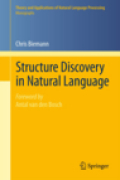
Current language technology is dominated by approaches that either enumerate a large set of rules, or are focused on a large amount of manually labelled data. The creation of both is time-consuming and expensive, which is commonly thought to be the reason why automated natural language understanding has still not made its way into “real-life” applications yet. This book sets an ambitious goal: to shift the development of language processing systems to a much moreautomated setting than previous works. A new approach is defined: what if computers analysed large samples of language data on their own, identifying structural regularities that perform the necessary abstractions and generalisationsin order to better understand language in the process?. After defining the framework of Structure Discovery and shedding light on the nature and the graphic structure of natural language data, several procedures are described that doexactly this: let the computer discover structures without supervision in order to boost the performance of language technology applications. Here, multilingual documents are sorted by language, word classes are identified, and semantic ambiguities are discovered and resolved without using a dictionary or other explicit human input. The book concludes with an outlook on the possibilities implied by this paradigm and sets the methods in perspective to human computer interaction. The target audience are academics on all levels (undergraduateand graduate students, lecturers and professors) working in the fields of natural language processing and computational linguistics, as well as natural language engineers who are seeking to improve their systems. The book sets an ambitious goal: to shift development of language processing systems to a much more automated setting than previous works. A new approach is defined. All software described is open source and freely available. INDICE: Foreword by Antal van den Bosch. 1.Introduction. 2.Graph Models. 3.SmallWorlds of Natural Language. 4.Graph Clustering. 5.Unsupervised Language Separation. 6.Unsupervised Part-of-Speech Tagging. 7.Word Sense Induction and Disambiguation. 8.Conclusion. References.
- ISBN: 978-3-642-25922-7
- Editorial: Springer Berlin Heidelberg
- Encuadernacion: Cartoné
- Páginas: 178
- Fecha Publicación: 31/12/2011
- Nº Volúmenes: 1
- Idioma: Inglés
